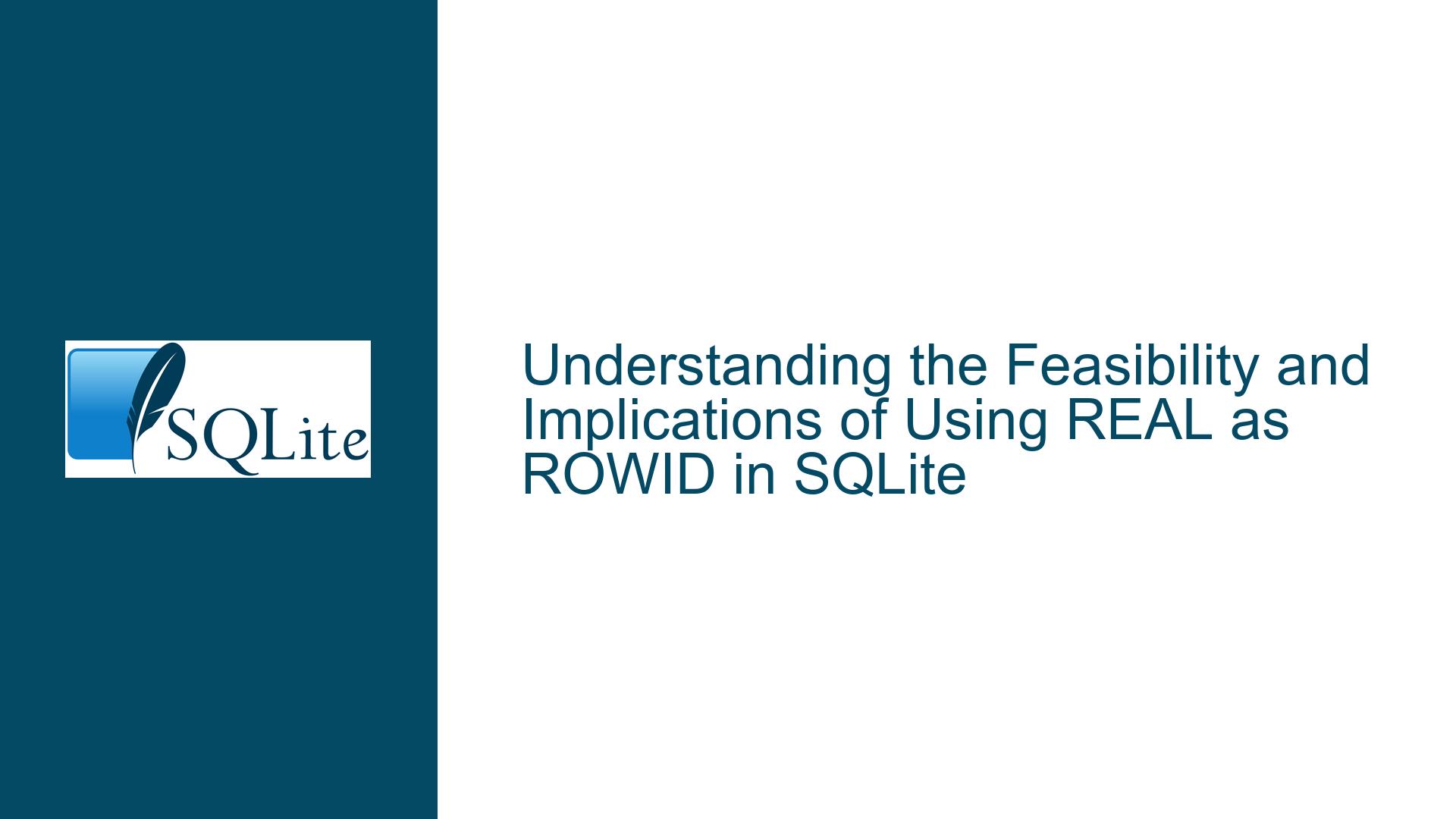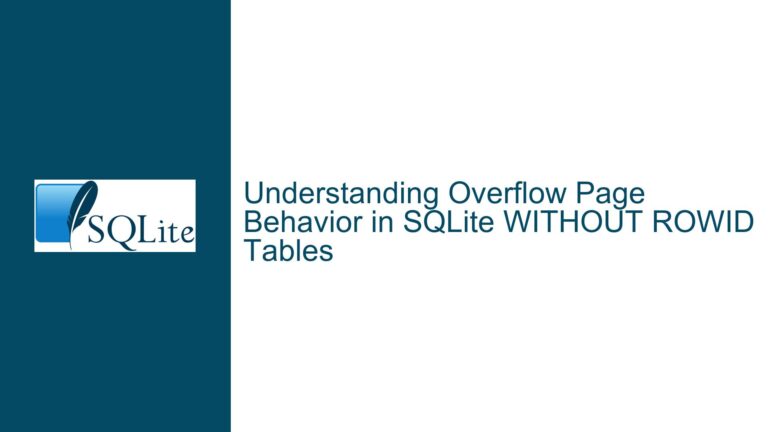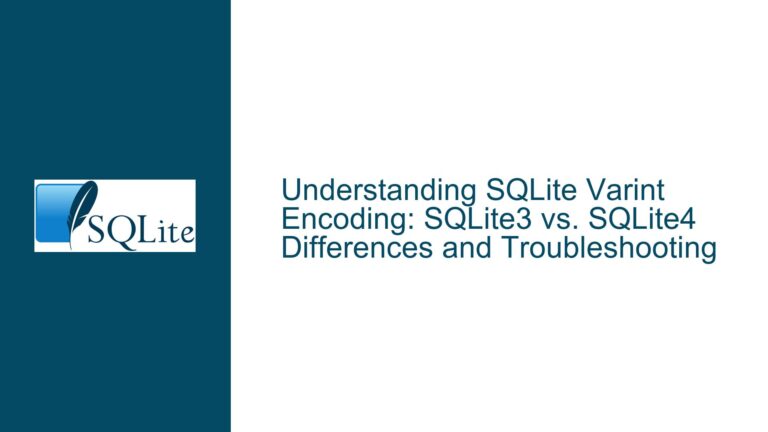the Feasibility and Implications of Using REAL as ROWID in SQLite
The Challenge of Interpreting REAL as ROWID in SQLite’s B-Tree Structure
Issue Overview
The core issue revolves around the feasibility of using a REAL data type as a ROWID in SQLite by interpreting its byte signature as a 64-bit integer. The ROWID in SQLite is a unique identifier for each row in a table, typically an integer that is automatically assigned and incremented. The proposal suggests that since both REAL and INTEGER types occupy 8 bytes, the B-Tree structure used by SQLite could theoretically interpret the byte signature of a REAL as a 64-bit integer, allowing REAL to serve as a ROWID.
However, this proposal faces significant technical challenges. The primary concern is the difference in how REAL and INTEGER values are represented and sorted in memory. While both data types occupy 8 bytes, their internal representations and the rules governing their comparison and sorting are fundamentally different. This discrepancy leads to complications in the B-Tree’s ability to maintain order and perform efficient lookups, especially when dealing with range queries and special floating-point values like NaN, inf, and -inf.
Possible Causes of Incompatibility
The incompatibility arises from several key differences between REAL and INTEGER data types:
Sort Order Differences: The sort order of 64-bit patterns differs significantly when interpreted as 2’s complement integers (
INT64) versus IEEE 754 floating-point values (FP64). For example,0.0and-0.0are considered equal in floating-point arithmetic but would have different binary representations and thus different sort orders when interpreted as integers. This discrepancy would disrupt the B-Tree’s ability to maintain a consistent and predictable order, which is crucial for efficient data retrieval.Special Floating-Point Values: Floating-point numbers include special values such as
NaN(Not a Number),inf(infinity), and-inf(negative infinity). These values do not have direct equivalents in integer representation and would require special handling. For instance, comparingNaNvalues is not straightforward, as they are not considered equal to any other value, including themselves. This would complicate the B-Tree’s comparison logic, which relies on a consistent and transitive ordering function.Incrementing REAL Values: The proposal to use
REALas aROWIDwould also face challenges with auto-incrementing values. Incrementing an integer by 1 is straightforward, but incrementing a floating-point value by 1 could result in a value that is orders of magnitude larger due to the nature of floating-point representation. This would make it difficult to generate sequentialROWIDvalues, which is a common requirement for many applications.B-Tree Dependence on Sort Order: The B-Tree structure used by SQLite relies heavily on the sort order of keys to maintain its hierarchical structure. Internal nodes contain key values in sorted order, separated by node references to the next level of the tree. Leaf nodes contain records in sorted order and are linked together in sort order. Any inconsistency in the sort order would disrupt the B-Tree’s ability to efficiently locate and retrieve records, especially when performing range queries.
Troubleshooting Steps, Solutions & Fixes
Given the technical challenges outlined above, it is clear that using REAL as a ROWID in SQLite is not feasible without significant modifications to the database engine. However, there are alternative approaches that can achieve similar functionality without compromising the integrity and performance of the B-Tree structure.
Using REAL as a Primary Key Without ROWID: SQLite already provides a mechanism for using
REALas a primary key without relying on theROWID. By creating a table with theWITHOUT ROWIDoption, you can define aREALcolumn as the primary key. This approach avoids the need to interpretREALvalues as integers and allows you to use floating-point numbers as unique identifiers. However, it requires that theREALprimary key be explicitly provided for each insert operation, as it will not be automatically generated like aROWID.CREATE TABLE fptable( ID REAL NOT NULL PRIMARY KEY, ... ) WITHOUT ROWID;Fixed-Point Representation: If the goal is to use floating-point values as identifiers while maintaining the ability to auto-increment, a fixed-point representation can be used. In this approach, the
ROWIDis treated as a fixed-point integer, and the corresponding floating-point value is derived by dividing theROWIDby a scale factor and adding an offset. This allows for sequentialROWIDgeneration while still representing the values as floating-point numbers when retrieved.-- Example of fixed-point representation SELECT rowid, (rowid / 1000.0) + 0.5 AS real_value FROM mytable;Custom Comparison Functions: If the use of
REALas aROWIDis absolutely necessary, it may be possible to implement custom comparison functions that handle the special cases of floating-point values. This would involve modifying the SQLite source code to include a custom comparison function that correctly handlesNaN,inf, and-infvalues. However, this approach is highly complex and would require extensive testing to ensure that it does not introduce new issues or performance bottlenecks.Avoiding Special Floating-Point Values: If the use of
REALas aROWIDis limited to a specific range of values that do not include special floating-point values, it may be possible to implement a workaround. For example, you could define a range of validREALvalues and ensure that allROWIDvalues fall within this range. This would avoid the complications associated withNaN,inf, and-infvalues, but it would also limit the flexibility of usingREALas aROWID.Alternative Database Solutions: If the requirement for using
REALas aROWIDis critical and cannot be satisfied within SQLite, it may be necessary to consider alternative database solutions that natively support floating-point primary keys. Some databases, such as PostgreSQL, offer more flexible data type handling and may provide the necessary functionality out of the box. However, this approach would involve migrating the entire database, which may not be feasible for all applications.
In conclusion, while the idea of using REAL as a ROWID in SQLite is intriguing, it is not feasible due to the fundamental differences in how REAL and INTEGER values are represented and sorted. The B-Tree structure’s reliance on a consistent and transitive ordering function makes it incompatible with the special cases and sort order discrepancies inherent in floating-point arithmetic. However, alternative approaches such as using REAL as a primary key without ROWID, fixed-point representation, and custom comparison functions can provide similar functionality without compromising the integrity and performance of the database.






